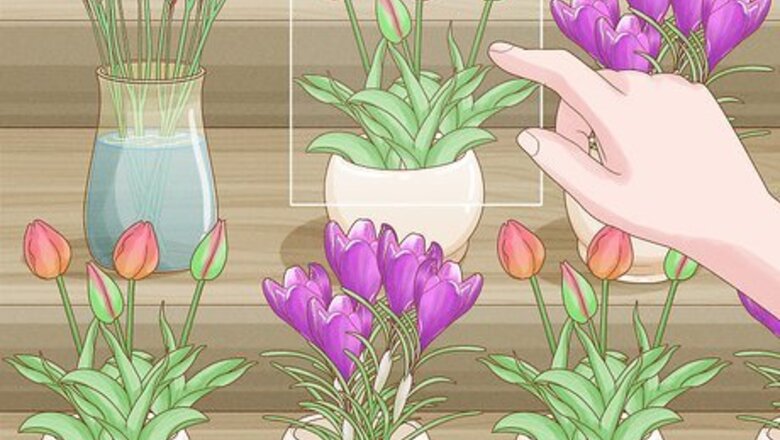
views
- Select a tulip bouquet that is full of lightly colored and tightly closed blooms.
- Cut the stems at a 45° angle, remove the bottom leaves, and place the tulips in cold water.
- Set the vase in indirect light away from heat and change the water daily.
Select a bouquet with unopened flower buds.
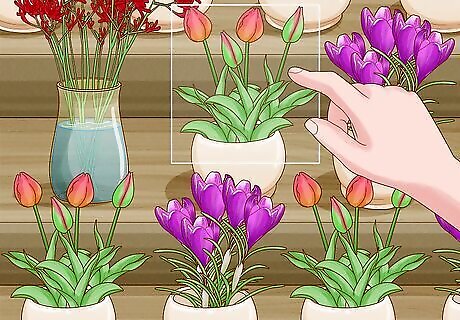
Choose tulip blooms that are lightly colored and tightly closed. While you might be tempted to buy tulips with fully-opened petals, they won’t last as long as unopened buds. Selecting a bouquet with closed blooms helps extend the tulips’ vase life from 5 days to over a week. The flowers open over the course of a few days, letting you enjoy their sweet buds and gorgeous, bright blooms. If you're growing your own tulips, cut the flowers before they’re fully opened and as close to the ground as possible.
Wrap the stems in a wet cloth or paper towels.
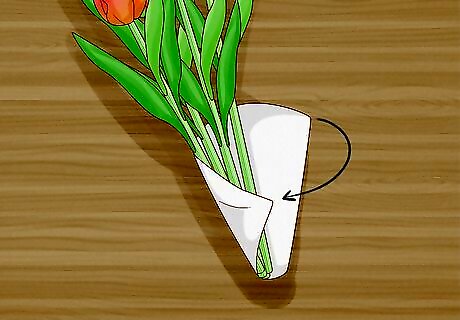
Covering the stems keeps them from drying out on your way home. Any time the tulips are out of water, they start to get dehydrated and age faster. Even if the distance from the flower shop to your house isn't very far, wrap the stems in damp paper towels or a washcloth to ensure they don't prematurely dry out.
Cut the stems at a 45° angle.
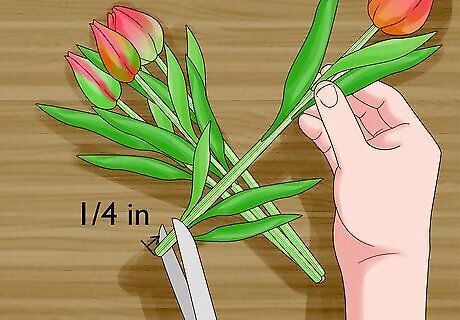
Trim ¼ in (0.6 cm) from the end of the stems at an angle. Cutting the stems at an angle gives the flower more surface area to soak up water, allowing them to stay hydrated and fresh looking for longer. Just use a clean pair of clippers to snip each tulip stem at a 45° angle.
Fill a clean vase with cold water.
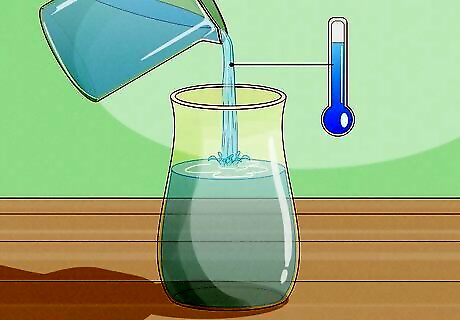
Cold water and a freshly washed vase keep blooms perky for longer. Choose a vase that’s at least half as tall as the tulip stems. Simply wash it with soap and water to ensure it doesn’t have any dirt or grime left over from your last bouquet. Then, fill the vase about ½ full with cold water. Tulips are one of the only flowers that keep growing while they’re in a vase. Using a tall vase can prevent elongating blooms from bending over and wilting. Always clean your vases before adding fresh flowers. A dirty vase full of bacteria can cause your flowers to rot more quickly. Cold water helps keep the flower stems fresh and crisp, while warm or hot water can cause them to get weak and soggy.
Remove the leaves from the base of the stems.
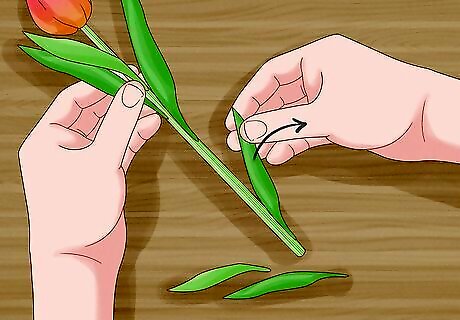
Submerging leaves below the waterline can spoil the tulips. Look for any leaves on the tulip stems that will be submerged in the water when you put them in the vase. Then, snip or gently pull off the leaves. The leaves can rot in the water and infect the flowers, causing them to go limp or die more quickly than usual.
Insert the tulips in the vase.
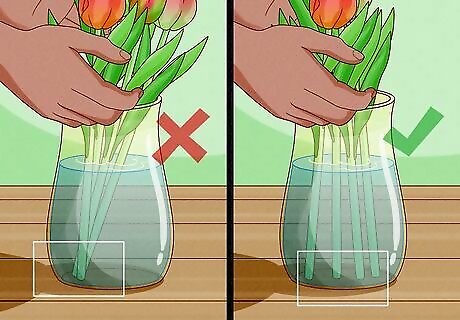
Arrange the flowers so they all have room inside the vase. Giving each stem plenty of space, rather than leaning them on top of one another, prevents them from crushing each other. When tulips are squeezed tightly inside a vase, the petals can drop prematurely and shorten the lifespan of your flowers. Use a mixture of short and tall tulips to improve the breathing room in the vase and make a more eye-catching arrangement.
Sprinkle flower food into the water.
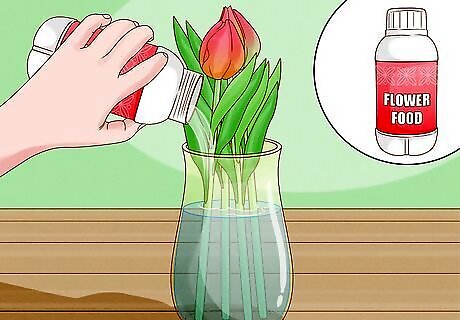
Adding flower preservative helps lengthen the tulips’ lifespan. Most flower bouquets come with a packet of nutrient-rich flower food to keep your tulips standing tall and looking perky. Just read the instructions on the packet to find out how much food to add for the amount of water in the vase; do not dump in the entire contents at once. Sprinkling flower food in the vase is more effective at preserving your flowers than household tricks like adding lemon juice, pennies, and other materials.
Trim the stems and change the water every day.
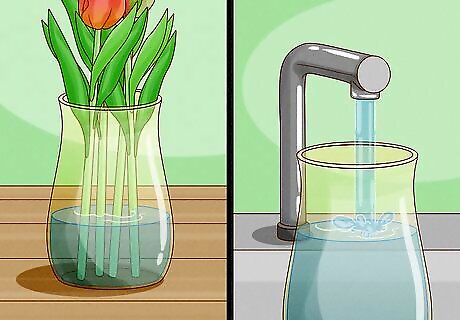
Replace the water with fresh, cold water daily. Tulips drink a lot of water to stay hydrated and looking perky and fresh. Every day, pour out the water in the vase, recut the bottom of the stems at a 45° angle, and add in fresh, cold water. This also helps prevent bacteria from accumulating in the vase that can cause the tulips to wilt prematurely. If you see the water level getting low during the day, top off the vase with fresh, cold water. Sprinkle more flower food into the water after each water change.
Place the flowers in indirect light and away from heat.
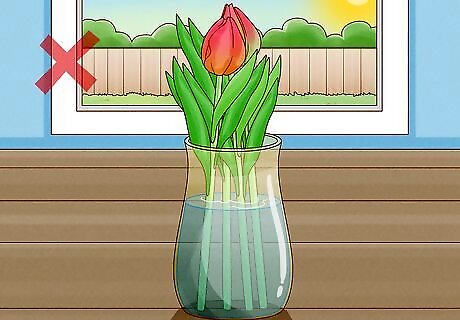
Setting the vase in a warm, sunny spot can cause tulips to wilt. Tulips are phototropic flowers, which means that they move toward their light source. The best way to keep them straight and perky is to place them in a spot that gets indirect, equal light from all sides. Just set them in a room that’s away from direct light, a heater, or an oven because heat can cause the tulips to wilt. In the evening, move your tulips to a cool spot, like your refrigerator or garage, to help preserve them for longer. Keep your flowers away from fruits like bananas, apples, and avocados. These fruits produce ethylene gas which can cause your tulips to age and wilt faster. If your tulips start to bend, rotate the vase every day to ensure the flowers get an equal amount of light. Or, poke a pin through 1 side of the stem (not all the way through to the other side) and just underneath the flower. This helps release air bubbles inside the stem that cause the tulip to droop.
Avoid using daffodils in your arrangement.
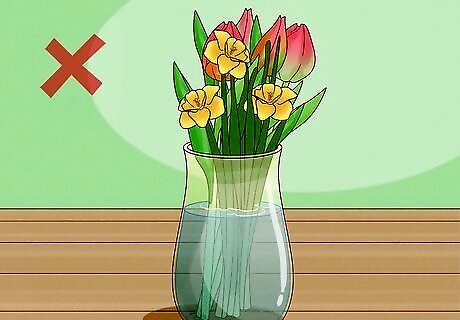
Tulips can wilt when arranged with flowers in the Narcissus species. Daffodils and other flowers in the Narcissus species exude a toxic sap that poisons the water and causes other flowers to fade and die faster. Tulips typically last longer and look fresher in vases all by themselves. It’s safe to arrange tulips with most other flowers, like hydrangeas and roses.
















Comments
0 comment